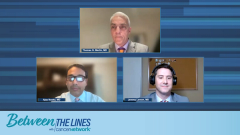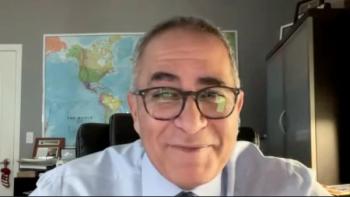
Relapsed/Refractory Multiple Myeloma: Practice Pearls and Future Directions in Care
Thomas Martin, MD; Ajay Nooka, MD; and Jeremy Larsen, MD, share closing thoughts on the evolving landscape of cytokine release syndrome management in relapsed/refractory multiple myeloma.
Transcript:
Thomas G. Martin, MD: Ajay, what patient is a perfect candidate? For what patient wouldn’t you use teclistamab or a bispecific T-cell engager?
Ajay Nooka, MD, MPH, FACP: The perfect candidate is a patient who’s rapidly progressing and who needs this BCMA-targeted strategy right away. That’s more effective. Given the efficacy of 63%, 2 of 3 patients will respond. This would be a go-to drug for me [when] I need an immediate option to treat right away. There are patients who I don’t feel comfortable treating with [this], like patients in their 90s. I wouldn’t put them in the basket of transplant ineligible. I’ve treated a few transplant-ineligible patients because their CRS [cytokine release syndrome] was mild, and you can easily get away with using appropriate management for the CRS with borderline organ functions. If patients had severe organ functions and COPD [chronic obstructive pulmonary disease] or had smoked significantly, they typically have significant heart failure. I’m concerned that if there was a CRS, will they be able to withstand it? If the answer is no, those are the patients that I’m not giving bispecific antibodies to.
Thomas G. Martin, MD: I completely agree. For patients in the upper 80s and 90s, that’s tough. There are some really fit patients in that category, and they can do it. In fact, we have a real-world experience. We sent an abstract out into IMS [incidental medical services] in the last couple of days. The age range was 38 to 91. In our group we’ve done them in the 90s, but it’s challenging. They’ve got to be a tough 90-year-old. Jeremy, when you send these patients to the community, [are there] any other strategies that you tell the local docs [what to watch for], what to inform you about?
Jeremy Larsen, MD: The big thing is I consider this a partnership. Generally, we still have patients, especially early on, with a foot in both worlds. Perhaps I’m seeing them quarterly once the patient is stable and responding. Prophylaxis, from an antimicrobial standpoint, is a big 1. Obviously our herpes shingles prophylaxisis usually along the lines of acyclovir. The BCMA class effect of the hypogammaglobulinemia is the other big thing, and we’re starting to see various data that have been put there. Sinai [Mount Sinai Health System] a little while back showed the efficacy of things like IVIg [intravenous immunoglobulin] for patients with hypogammaglobulinemia in reduce bacterial events. In this study, if I recall, there were 2 patients with pneumocystis. Bactrim or some equivalent of that is another big part of this.
We’d all love to put COVID-19 entirely behind us. We’re thinking about the role of immunizations and those types of things as much as possible to protect the patient. Ensuring prophylaxis is there, and we’re trying to be very explicit about the treatment plan. Later on, that’s where some of the ICANS [immune effector cell-associated neurotoxicity syndrome] and less frequent neurotoxicity events, like Guillain-Barre [syndrome], can happen. That’s where [you’ll want] an experienced neurologist in those rare cases where we needed further testing.
Thomas G. Martin, MD: Awesome. Dr Nooka, any last thoughts?
Ajay Nooka, MD, MPH, FACP: No. 1, using tocilizumab hasn’t affected the efficacy. For a patient who’s hesitant to use tocilizumab, this is a matter of confidence and corroboration, that using tocilizumab didn’t affect efficacy. No. 2, always redose only when the CRS grade goes down to less than 1. No. 3,never dose the patient if they have an active infection. You always have to make sure the patient doesn’t have an active infection going on. These 3 rules are the ones that I always communicate very openly to the community physician when I’m transitioning. If you remember…there was 1 event at cycle 6 and cycle 5, in which the patient was dosed at the time of an active infection. Once the patient is beyond the academic environment and going into the community, understanding this is crucial: who not to dose. That’s how I communicate.
Thomas G. Martin, MD: I couldn’t agree more. Some of the therapies we use, if a patient comes in with a URI [upper respiratory infection], we say, “They’re not febrile. Give them the carfilzomib or the daratumumab.” But this is a therapeutic where I say, “No, don’t give it right now. They can come back next week when their symptoms are better.” I worry about the dosing when patients have infections. [That’s a] very important point.
We’re all very excited about the implementation of teclistamab into our treatment modalities for relapsed/refractory multiple myeloma. The last thing I’ll say is that it’s so active that our typical pathway should be followed. When something works so well in relapsed and refractory, especially in alaterline, we need to bring it earlier on in the therapy. Those studies are ongoing in early relapse as part of maintenance postautologous transplant and frontline therapy. I always say: you don’t put LeBron James on the bench for the first 3 quarters and then use him in the fourth; you use him in quarter 1. It’s the same thing with these therapeutics. I look forward to seeing those data as they roll in over the next 2 to 5 years.
Thank you for a great conversation this morning. Thank you for reviewing that journal article.
Ajay Nooka, MD: Thanks.
Jeremy Larsen, MD: Thanks so much. It was a pleasure.
Transcript edited for clarity.
Newsletter
Stay up to date on recent advances in the multidisciplinary approach to cancer.


















































































